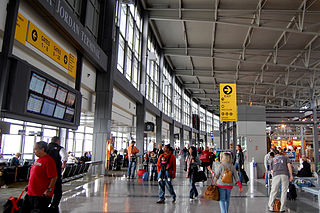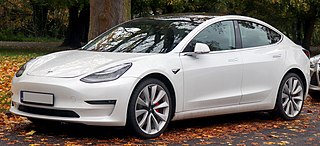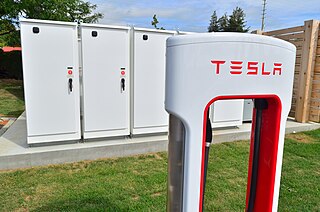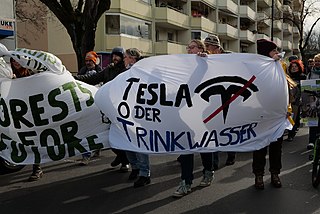
Elon Reeve Musk is a business magnate and investor. He is the founder, CEO, and Chief Engineer at SpaceX; angel investor, CEO, and Product Architect of Tesla, Inc.; founder of The Boring Company; and co-founder of Neuralink and OpenAI. With an estimated net worth of around US$221.4 billion as of July 2022, Musk is the wealthiest person in the world according to both the Bloomberg Billionaires Index and Forbes' real-time billionaires list.
Tesla, Inc. is an American multinational automotive and clean energy company headquartered in Austin, Texas. Tesla designs and manufactures electric vehicles, battery energy storage from home to grid-scale, solar panels and solar roof tiles, and related products and services. Tesla is one of the world's most valuable companies and remains the world's most valuable automaker with a market capitalization of more than US$760 billion. The company had the most worldwide sales of battery electric vehicles and plug-in electric vehicles, capturing 23% of the battery-electric market and 16% of the plug-in market in 2020. Through its subsidiary Tesla Energy, the company develops and is a major installer of photovoltaic systems in the United States. Tesla Energy is also one of the largest global suppliers of battery energy storage systems, with 3.99 gigawatt-hours (GWh) installed in 2021.

Del Valle is an airport-defined edge city of Austin and part of the Austin–Round Rock–San Marcos Metropolitan Statistical Area. It is founded upon the 19th-century Santiago Del Valle leagues, the largest granted land parcel in Travis County.
SolarCity Corporation was a publicly traded company headquartered in Fremont, California that sold and installed solar energy generation systems as well as other related products and services to residential, commercial, and industrial customers. The company was founded on July 4, 2006, by Peter and Lyndon Rive, the cousins of SpaceX and Tesla, Inc., CEO Elon Musk, and nephews of model Maye Musk. Tesla acquired SolarCity in 2016, at a cost of approximately $2.6 billion and reorganized its solar business into Tesla Energy.

Tesla's Fremont Factory is an automobile manufacturing plant in Fremont, California, operated by Tesla, Inc. The facility opened as the General Motors Fremont Assembly in 1962, and was later operated by NUMMI, a former GM–Toyota joint venture. Tesla took ownership in 2010. The plant currently manufactures the Model S, Model 3, Model X, and Model Y, employing 10,000 people as of June 2018.

The Tesla Model 3 is a compact executive sedan that is battery powered and produced by Tesla. Limited production of the Model 3 began in mid-2017, with the first production vehicle rolling off the assembly line on July 7, 2017. The official launch and delivery of the first 30 cars took place on July 28.

The Tahoe Reno Industrial Center is a privately owned 107,000 acres (167 sq mi) industrial park, located east of Reno, Nevada and south of Interstate 80. The center is the largest in the United States, occupying over half of the land mass in Storey County, and is home to more than a hundred companies and their warehouse logistics centers and fulfillment centers such as PetSmart, Home Depot, Walmart. and others. The Gigafactory 1 is being built there to serve Tesla Motors and Panasonic. Tesla says that once completed the Gigafactory will be the largest building on the planet.

The Tesla Powerwall is a rechargeable lithium-ion battery stationary home energy storage product manufactured by Tesla Energy. The Powerwall stores electricity for solar self-consumption, time of use load shifting, and backup power. The Powerwall was introduced in 2015 with limited production. Mass production started in early 2017 at Tesla's Giga Nevada factory. As of May 2021, Tesla has installed 200,000 Powerwalls.

Tesla Energy is the clean energy subsidiary of Tesla, Inc., headquartered in Fremont, California, that develops, manufactures, sells and installs photovoltaic solar energy generation systems, battery energy storage products, as well as other related products and services to residential, commercial and industrial customers.

The Tesla Powerpack is a rechargeable lithium-ion battery stationary energy storage product, intended for use by businesses or on smaller projects from power utilities. The device is manufactured by Tesla Energy, the clean energy subsidiary of Tesla, Inc. The Powerpack stores electricity for time of use load shifting, backup power, demand response, microgrids, renewable energy integration, frequency regulation, and voltage control. The first prototype Powerpacks were installed in 2012 at the locations of a few industrial customers.

The Tesla Model Y is a battery electric compact crossover manufactured by Tesla, Inc. Tesla unveiled it in March 2019, started production at its Fremont plant in January 2020, and started deliveries on March 13, 2020.

The Tesla Semi is an all-electric battery-powered Class 8 semi-truck in development by Tesla, Inc. Two concept vehicles were unveiled in November 2017, and production is planned in 2023.
This is the corporate history of Tesla, Inc., an electric vehicle manufacturer and clean energy company founded in San Carlos, California in 2003 by American entrepreneurs Martin Eberhard and Marc Tarpenning. The company is named after Serbian-American inventor Nikola Tesla. Tesla is the world's leading electric vehicle manufacturer, and, as of the end of 2021, Tesla's cumulative global vehicle sales totaled 2.3 million units.

Tesla Gigafactory Berlin-Brandenburg is a European manufacturing plant for Tesla, Inc. in Grünheide (Brandenburg), Germany. The campus is located 35 kilometres (20 mi) south-east of central Berlin and some 8 kilometres (5 mi) southeast of the Berlin state boundary at Erkner/Rahnsdorf. Proximity to Berlin Brandenburg Airport was explicitly cited as a factor in choosing the site. It is Tesla's first manufacturing location in Europe.

Tesla Giga New York is a photovoltaic (PV) cell factory leased by Tesla subsidiary SolarCity in Riverbend, Buffalo, New York. The factory, owned by the State of New York, was built on brownfield land remediated from a former steel mill. Construction of the factory, rebranded as RiverBend, started in 2014 and was completed in 2016–17.
Tesla Giga Shanghai is a factory in Shanghai, China operated by Tesla, Inc. The facility currently hosts the final assembly of the Tesla Model 3 and Tesla Model Y, with Model Y deliveries slated to begin in January 2021. The factory's initial production rate target is 3,000 cars a week, eventually ramping up to 250,000 electric cars per year. The first assembled Model 3s were delivered in December 2019, just twelve months after Tesla began site grading on the Gigafactory in December 2018.

Gigafactory Texas is an automotive manufacturing facility near Austin, Texas built by Tesla, Inc. Construction began in July 2020, limited production of Model Y began before the end of 2021, and initial deliveries of vehicles built at the factory took place at an opening party called “Cyber Rodeo” on April 7, 2022.

Tesla, Inc. has been criticized for its cars, workplace culture, business practices, and occupational safety. Many of the company's criticisms are also directed toward Elon Musk, its angel investor, CEO, and Product Architect. Critics have also accused the company of deceptive marketing, promises, and fraud. Some critics have highlighted Tesla's downplay of issues, and a few have been retaliated by the company for whistleblowing.




















